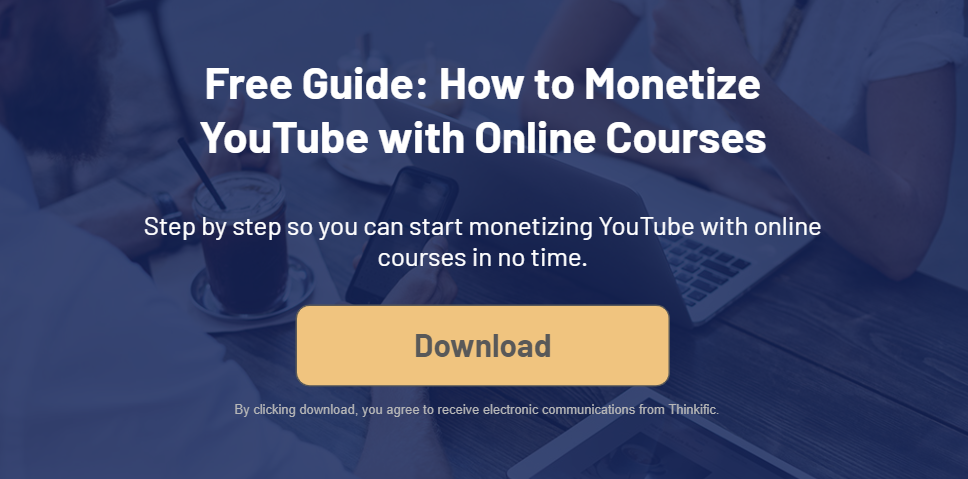You want to make money from YouTube.
You’re open to the idea of teaching online.
But at what point does your YouTube monetization model actually become a business?
To help you answer that question, we invited Tim Schmoyer to our YouTube Creator Summit.
Tim is the founder of VideoCreators.com, and today, leads a team of 10 staff to help YouTube creators like you, master YouTube so they can grow their audience, get more subscribers, get more views, and grow a business that ultimately reaches people and changes their lives.
Watch the video below to learn how to turn YouTube into your career by building a business model around your content and monetizing your channel:
Set Expectations When Starting To Monetize
As Tim mentions in the video, he focused on adding value for his viewers since his first blog went live in 2004.
And as part of his value-adding philosophy, he constantly gave things away for free.
So when he published his first book and tried to sell it for $15, his audience didn’t react positively.
The problem, as Tim highlights, was he didn’t set expectations to his audience that he would ever sell his content.
As a YouTube creator making the leap to selling online courses, you have to be aware of that.
To make this transition process smoother, Tim recommends you have a conversation with your audience about your intentions, and keep them in the loop that you are creating an online course.
You have to set an expectation of sales with your audience.Tim Schmoyer
Tim expands on this a little more in his video, above.
2 Keys to Making Money on YouTube
When it comes to lining yourself up in to sell online courses, there are two key elements you cannot rush or overlook.
And they are largely the same things that you need to grow your YouTube channel.
The first is your value proposition, and the second is your target audience.
Tim breaks down three ‘transactions’, or opportunities, for you to interact with your viewer to educate them on the value you offer:
- Transaction #1 – Click the thumbnail and start watching your video
- Transaction #2 – Subscribe to the channel to receive more content
- Transaction #3 – Take things to the next level by buying your online course
The goal is to be aware of the value you’re adding at each step and whether it’s compelling enough for them to move from each step to the next.
For example, if your audience is already consuming value for free on your channel (Transaction #2), then the value you’re going to sell (Transaction #3) would have to be ten times that value and something that people would be willing to pay for.
Another thing Tim stresses is the need to get highly specific about who you’re adding value for – beyond just age, demographic, gender and location.
You need to really understand their story and intimately know:
- What troubles they’re experiencing
- What fears they have
- What holds them back
- What they aspire to
Then clearly communicate that through the branding of your channel.
Tim dives into more depth in the video of how you can engage with your audience effectively on an emotional level rather than just cognitively once you understand your audience to this level of detail. Watch to learn more!
Strategies To Sell Your Online Course on YouTube
A common mistake YouTube creators make when integrating online courses into their channel is they try to sell their product in every video.
This is a mistake because it can turn viewers off and away from YouTube – something that YouTube as a platform does not want.
As a result, your video is less likely to be recommended and discoverable.
To help you strike a fine balance between giving value as well as pitching on your channel, Tim recommends 3 types of video content as part of your overall strategy:
Discoverable Content
- The goal of this type of content is to reach new viewers who have never seen your channel before. The style tends to be a little more produced and polished and the call-to-action is simply to watch more videos.
Community Content
- The goal is to increase the know, like and trust factor that you have with your audience. These tend to be a little more laid back and informal, and the main call-to-action is engagement, through things like comments.
Sales Content
- This is where the goal is to get your audience off YouTube. The call-to-action is simply to click a link or enter a URL.
These three elements will ensure that you grow your subscriber base and business, and the key thinking that underlies this is awareness of your customer journey.
In other words, what is the step-by-step process of how people will convert from a viewer into a sale?
Free Resource: If you’d like to learn more about mapping out your customer’s journey, check out our free video on How To Build An Automated Sales Funnel For Your Online Course
9 Ways To Make Money On YouTube
Tim shared 9 different revenue streams to make money on YouTube, including:
- AdSense
- Crowdfunding
- Brand deals
- Speaking
- Licensing
- Affiliates
- Live events
- Consulting
- Product Sales
In his video, Tim breaks down what each of these mean, how much each stream contributes to the bottom line of his own business. He also shares why selling your own courses is the one of the best ways to monetize YouTube, out of all nine.
Sell one thing. And sell it very well.Tim Schmoyer
How To Create Content For Your Online Course
A common question that comes up for YouTube creators is how to differentiate between the content they create for free and content they create for their online course.
Contrary to what you might think, Tim recommends giving away your best material for free on YouTube.
The reason is that it establishes credibility, trust, and allows you to serve people to the best of your ability.
What you then sell for your online course, is more or less the same content.
But the key difference is it’s organized into a process. A process that will take them from A to B.
Sell processes and results. Don’t think of it as selling material.Tim Schmoyer
Are you new to online courses? Check out this helpful step-by-step guide to creating and selling online courses!
How To Price Your Online Course
Ok. So you’ve got your online course. You’ve got your video strategies to help sell those courses.
But how much do you charge for your online course?
Here’s a summarized 4-step process (more details in the video) that Tim recommends based on his experiences:
- Study the market
- Pick a price
- Don’t make it concrete
- Adjust as appropriate
One thing that Tim suggests is to never tell people what your price is on your channel.
The reason for this is so you can adjust your prices without having to re-shoot or edit videos.
And on that note, it’s always easier to start too low, then slowly work your way up, than to charge a high price, then bring it back down when you’re not making enough sales.
Because then the people who bought from you first would feel like they were punished for being the early bird.
Related article: here’s a helpful guide to pricing your online course.
The 5 Most Common Pitfalls of YouTube Monetization
As you’ll learn from listening to Tim’s story, he’s been earning money from YouTube for quite some time. Along the way, he’s made many mistakes on the way to building a successful business.
He often notices YouTubers share in these mistakes as they navigate their journey on YouTube. Here are the 5 most common pitfalls he sees video creators face when they first start to monetize:
- Assuming you know how to sell
- Creating a product without testing it first
- Trying to sell in every video
- Not aligning your product with your channel’s target audience and value proposition
- Selling something you don’t actually believe in
To hear more about Tim’s strategies for overcoming these pitfalls, watch the video above!
Connect with Tim Schmoyer at videocreators.com.
New to online courses? Learn everything you need to create and
launch your first course with this helpful guide!









